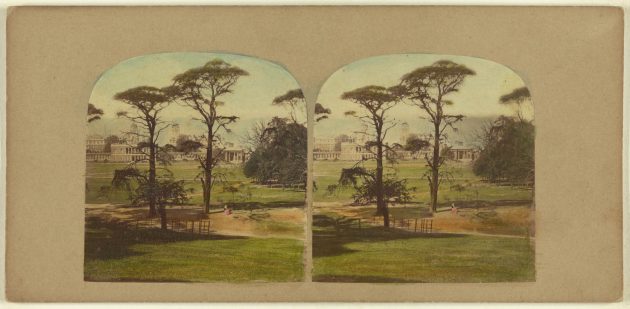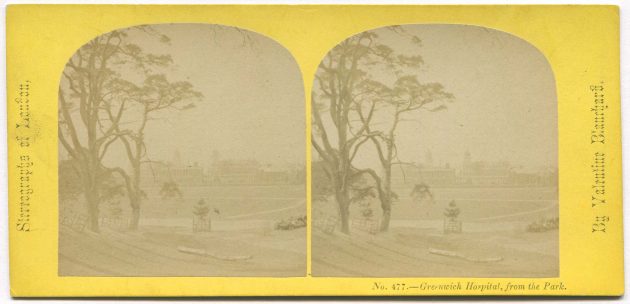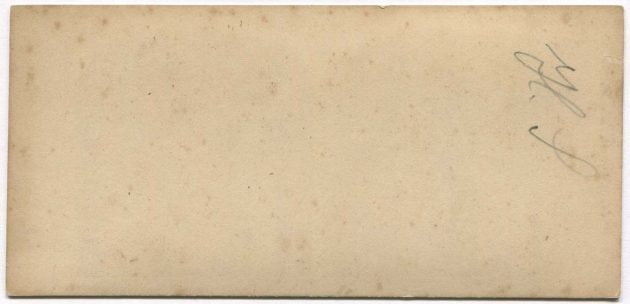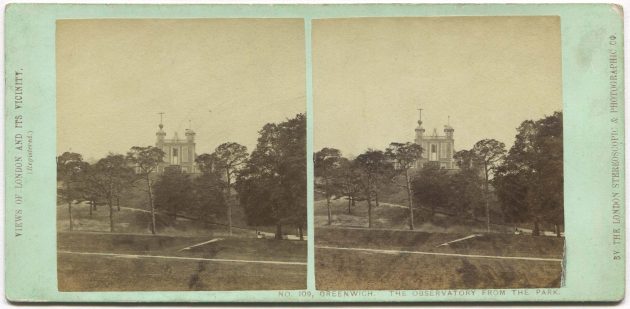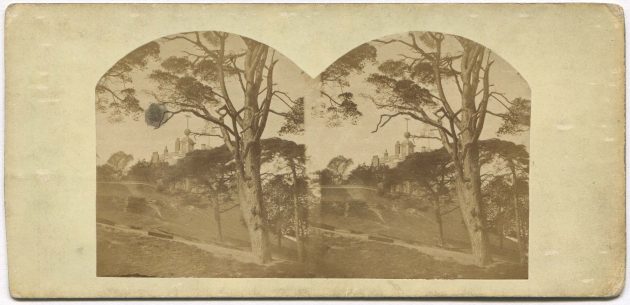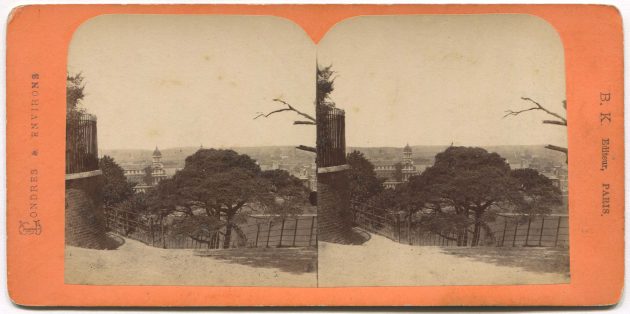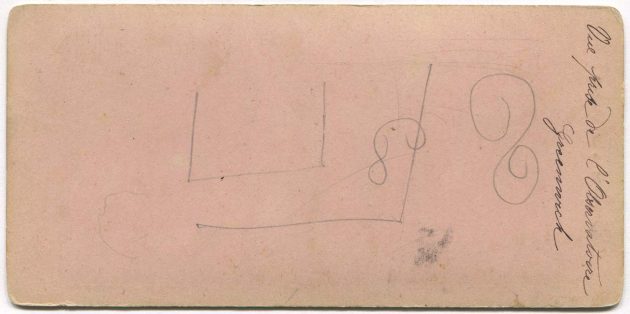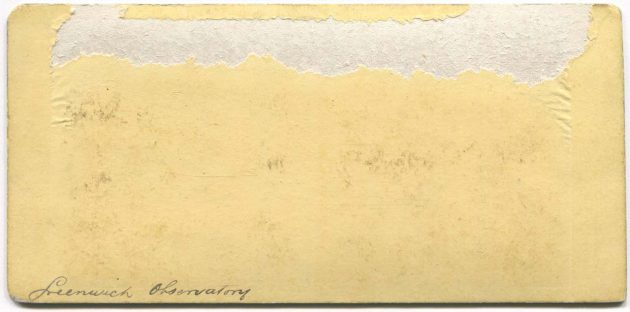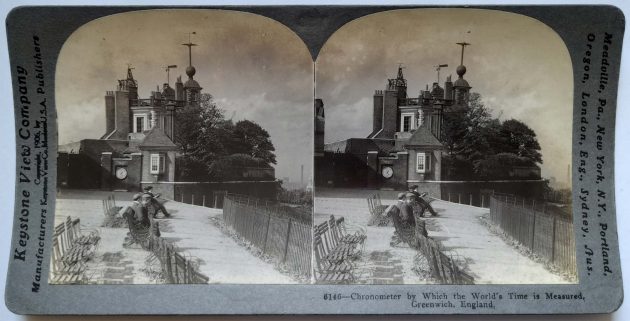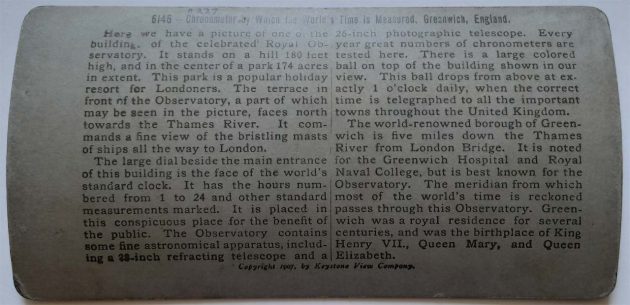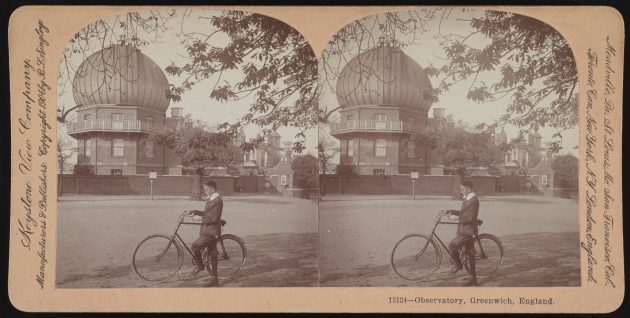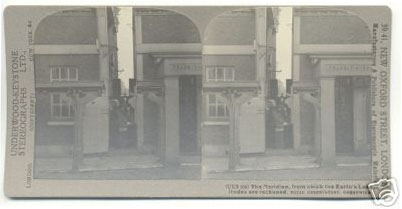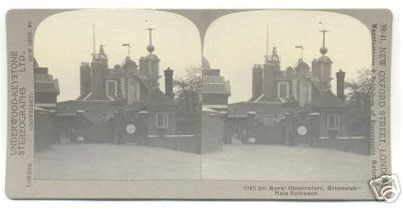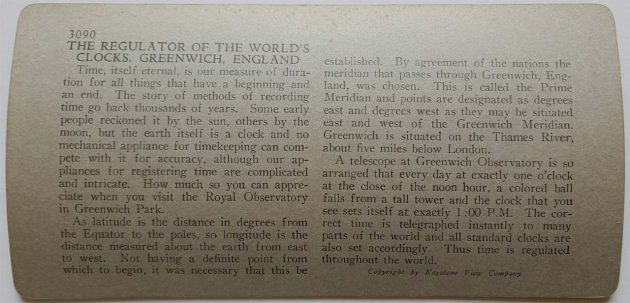…where east meets west
- Home
- Brief History
- The Greenwich Meridian
- Greenwich
(1675–1958) - Herstmonceux
(1948–1990) - Cambridge
(1990–1998) - Outstations (1822–1971)…
- – Chingford (1822–1924)
- – Deal
(1864–1927) - – Abinger
(1923–1957) - – Bristol & Bradford on Avon
(1939–1948) - – Bath
(1939–1949) - – Hartland
(1955–1967) - – Cape of Good Hope
(1959–1971)
- Administration…
- – Funding
- – Governance
- – Inventories
- – Pay
- – Regulations
- – Royal Warrants
- Contemporary Accounts
- People
- Publications
- Science
- Technology
- Telescopes
- Chronometers
- Clocks & Time
- Board of Longitude
- Libraries & Archives
- Visit
- Search
Stereoviews of the Observatory at Greenwich
page under construction
The known stereoviews of the Observatory and the views of Greenwich Hospital (later the Royal Naval College) which were taken from it, exist in a wide variety of formats. They include:
- prints mounted and bound in as plates in a magazine
- magic lanterns slides (or pairs of slides) of varying sizes
- prints mounted on a flat card of standard size (seven by three and a half inches)
- prints mounted on curved card mounts of standard size.
To enhance the 3D effect, photographers often included objects in the foreground. This included trees, which all too often partially obscured the very subject being photographed. By the 1890s, newly installed seating in the area in front of the Observatory gates provided a useful foreground subject.
The Observatory in the 1850s
One of the earliest known stereoviews of the Observatory was published on 1 July 1858 in the first ever edition of The Stereoscopic Magazine, (Lovell Reeve, London). Published monthly between July 1858 and February 1865, each issue usually containend three photographic stereoviews, each mounted on a single page with a description following. Those of the first edition at least, were produced under the superintendence of James Glaisher, who had developed his photographic expertise during the course of his work at the Observatory. Although Glaisher oversaw the prodcution of the images (and was described as The Magazine's editor in a review), the images were actually printed by A.J. Melhuish, whose premises were close to the Observatory at nearby Osborne Place in the centre of Blackheath Village. The image of the Observatory probably dates from 1857.
In the mid 1850s, the printing process was slow as each print needed a lengthy daylight exposure, limiting production from each negative to perhaps just half a dozen prints per day – if only one negative was available (as was typically the case), a whole year was required to print a number sufficient for circulation. In Volume 3, it was explained that 'many experiments were tried to make duplicate negatives by copying, but it was found impossible to copy a negative without detereoration or loss of half-tints, and the idea was abandoned.'. By the time Volume 3 were published, subjects were photographed with cameras capable of taking several sets of images at once. In the case of Roger Fenton at the British Museum, they were 'taken by a camera with six lenses, three pairs of views being taken simultaneosuly on one sheet of glass.'
For the Observatory stereoview, multiple pairs of images were shot from the same location. The stereoview exists in at least three (and probably rather more) different versions as can be seen by variations in the openess of the central window of the Octagon Room (the large sash window in the centre) and the position of the Osler Anemometer on the western (right-hand) turrett.
Both the images below have been trimmed by an earlier owner to fit a standard stereoscope. Both are blank on the reverse. In the top image, the bottom sash of the Octagon Room window is open and the top sash shut. In the second, the bottom sash is closed and the top sash open. Note too, the different position of the anemometer.
********
Click here to read a transcript of the article that accompanied the image.
Each edition of the The Stereoscopic Magazine cost 2s. 6d., whilst the "Book Steresocope" (which was constructed under the direction of Glaisher, by Messrs. Negretti and Zambra, 'to fold like a map without detriment to its stereoscopic action') cost 3s. 6d. Click here for a whole page advert from July 1858 promoting the Magazine. By the time the stereoview of the Observatory was published it was out of date, because by then, the sash window had been replaced with one consisting of a single piece of plate glass. If he didn’t take the photo of the Observatory himself, it is likely, that Glaisher was present when it was taken as a vey similar (much larger) single photographic image of about the same date by Glaisher is preserved in the Observatory Archives (RGO116/9). Another exists in the archives of Historic England (Click here to view).
The Stereoscopic Magazine, was not the first collaboartion between Lovell Reeve, Glaisher and Melhuish, as the previous year, they had all been involved in the production of Charles Piazzi Smyth's volume Teneriffe, an astronomer's experiment which contained 20 stereographs and was the first ever book to be so illustrated. Click here for a whole page advert from December 1857 promoting the book. Click here for an overview of the history of stereoviews in books.
Melhuish was a distinguished photograher in his own right and frequently exhibited his photographs. Click here for a list. Typically sold for either 15s. or 21s., they included a large photo taken in 1857 from the roof of Flamsteed House showing, in the distance, HMS Agemenmon shipping the transatlantic cable from Glass & Elliot's factory. Click here to view an advert marketing the print.
Views by The London Stereoscopic Company from the 1850s
Founded in 1854, London Stereoscope Company changed its name to The London Stereoscopic Company in 1856 and to The London Stereoscopic and Photographic Company in May 1859. These two hand tinted views would therefore apear to date from the period 1856-1859.
The first two images are different editions of the same view. They have different titles as well as a significant differences in their colouring. Why the first image has what appears to be a water stain in the same place on both halves is unexplained.
The third image, Greenwich Hospital as seen from outside the Observatory, has all the appearance of having been published by The London Stereoscopic Company, despite the absence of the embossed publishers stamp. It is reproduced courtesy of The J. Paul Getty Musuem, Object number: 84.XC.979.5915
********
********
Distant view from 1861
It is not known if HWG was the photographer, the owner or both. Nor is clear what the reference number 181 refers to. Nor is it known if the card was published commericially. The Observatory is visible behind the trees (centre-right).
View of Greenwich Hospital by Valentine Blanchard, c.1863-1865?
Click here to read about Valentine Blanchard
Two views by the The London Stereoscopic & Photographic Company c.1866–1873
These two views (card numbers 108 & 109) are from The London Stereoscpic Company's series Views of London and its vicinity. The form of the Courtyard gates and the location of the annemometer hut on the roof of Flamsteed House on card 108 date the views to c.1866-1873.
********
A view sold by John Bristed
Born in 1828, John Bristed, whose sticker is attached to the rear of this viiew, had a shop in the centre of Greenwich. It is not clear if he took the shot himself or was actinging as an agent. The view is difficult to date. It could be as early as the late 1850s given the appearance of the hill. On the other hand, given that the label indicates that Bristed had had his shop for for upwards of 30 years, it could date from as late as the 1880s.
The Royal Naval College and the corner of the Observatory Courtyard by B.K.editeur Paris
In the absence of a publisher's catalogue, this view is very difficult to date. The dead branches of the Scots Pine visible on the right, suggest that this shot may have been taken in the 1880s. It may however have been taken up to 20 years earlier of as late as the early 1890s. The Scots Pines gradually succumbed to air pollution and by 1894 the last of them had been felled.
View by B.W. Kilburn of Littleton, New Hampshire, first published in 1890
The curved card mount, was introduced by B.W. Kilburn in 1877 to accentuate the effect of three dimensions. The same form was adopted by the Keystone View Company (established in 1892) and also by others.
Copyrighted in 1891, the serial number (6052) suggests that it was published in 1890, which is consistent with the fact that the Porter's Lodge (erected in 1891) is not present. The two version of this view below, differ in that the second version also mentions James M Davis. Born in North Carolina in 1853, Davis sold stereocards for the Kilburn Brothers. He is also recorded as being a photographer of stereoviews. It is not known who took this particular shot.
The Kilburn Brothers Stereoscopic View Company
A view from the 1890s
These anonymously published versions of the same view dating from between 1891 and 1900 show two different production techniques. In the first, the two images have been mounted separately. In the other, both have been printed on the same sheet of paper. Note the difference in quality, only part of which is due to wear and tear.
********
Stereoviews from c.1895 in the collection of Historic England
These three stereoviews in the collection of Historic England are recorded as being by York and Son. The second image also exists as seperate negatives (CC97/01602 & CC97/01603, which appear to be duplicate copies of the original) and as a coloured magic lanterns slide. At least two of the views were also produced (presumably under licence) as postcards by other manufacturers. Links to these are given in the table below.
Description |
Reference and link |
Postcard view |
|
| View looking south-east from the roof of Flamsteed House | CC97/01244 | Link | |
| View from the Lower Garden looking north | CC97/01604 | Link | |
| View from the Observatory looking north | CC97/01650 |
Two views from c.1904 by the Keystone View Company
The Keystone View Company published several views of the Observatory between the start of the twentieth century and the 1930s. The two here were first published in the first few years of the twentieth century. Their serial numbers are 6146 and 13124 respectively. According to Leigh Gleeson, in the early years, B.L. Singley, the founder/president of the Keystone View Company, listed the copyright under his personal name (whether he was the photographer or not).
The angle of the path and the stonework beneath the Gate Clock indicates that the earliest date that the first stereoview could have been shot c.1900. The first of the two versions shown here has a copyright date of 1905. The second has a date of 1906 on the front and 1907 on the rear. Later versions are also known with no copyright date. A stereoview with the same caption but a different serial number and updated picture and text was released in 1930 (see later section below).
The version of the image from 1905 is reproduced courtesy of the Library of Congress. Reproduction number: LC-DIG-stereo-1s22223. A rear view is not available.
********
In the stereoview below, the tree to the left of the cyclist's head was reduced to the height shown here in 1903/4. Given that the first version carries, a copyright date of 1904, it seems reasonable to assume that is the year when the shot was taken. As well as being mounted on a different colour card, the second version carries no copyright date on the front. The first version of the image is reproduced courtesy of the Library of Congress. Reproduction number: LC-DIG-stereo-1s22225. Rear views are not available for either version.
********
Miniture French / German glass stereoview by Mignon Stéréo c.1900-1905
Measuring just 6.5 cm by 3 cm, this glass slide contains both images on a single piece of glass. Unlike a conventional magic lantern slide, it has no protective glass backing to prevent damage to the emulsion. Made in Germany, Mignon Stéréo claimed to be 'The smallest stereoscopical apparatrus of the world with exchangeable glass photos.'
Click here to see a Mignon Stéréo viewer.
Three views by Underwood Keystone c.1925-1933
On the assumption that all three images were taken on the same day, the first and the third views would suggest that they date from c.1925-1933. Rear views are not available.
********
********
Keystone View Company stereoviews from August 1930 by George Lewis
In 1978 the archive of the Keystone View Company was acquired by the University of California’s California Museum of Photography. Known as the Keystone-Mast collection, it consists of 250,000 stereoscopic glass-plate and film negatives and 100,000 vintage prints. The links below are to ten stereoviews taken in Greenwich Park that have been digitised by the Museum. All were taken by George Lewis, and eight show the Observatory. All are recorded as having been taken in August 1930 and are marked as file copies. Only the one above (marked* in the table below) is known to have been published.
Description |
Reference and link |
AccompanyingRecord |
|
| Observatory from the east without Great Equatorial | 1996.0009.KU93936 | Link | |
| Observatory from the east with Wolfe Statue and Great Equatorial (cat, no people) |
1996.0009.KU93916 | Link | |
| Observatory from the east with Wolfe Statue and Great Equatorial (same viewpoint, cat, no people) |
1996.0009.KU93917 | Link | |
| Observatory from the east with Wolfe Statue and Great Equatorial (same viewpoint, but with children and riden tricycle) |
1996.0009.KU93921 | Link | |
| * | Observatory from the east with Wolfe Statue and Great Equatorial (same viewpoint, but with seated children and unriden tricycle) | 1996.0009.3090 | Link |
| Observatory from the east (middle distance view) | 1996.0009.KU93918 | Link | |
| Observatory from the east (distant view) | 1996.0009.KU93919 | Link | |
| Children playing cricket with Observatory in the background | 1996.0009.KU93925 | Link | |
| Children playing cricket (Observatory not visible) |
1996.0009.KU93922 | Link | |
| Children playing cricket (Observatory not visible) | 1996.0009.KU93923 | Link |
Search page. Alternative search page. Use the search term George Lewis Greenwich
See also KeystoneDepth. Use the search term Greenwich Observatory
© 2014 – 2025 Graham Dolan
Except where indicated, all text and images are the copyright of Graham Dolan






